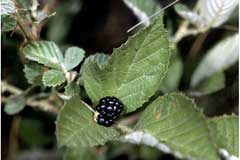Difference between revisions of "Rubus cuneifolius"
| Line 17: | Line 17: | ||
| range_map_caption = Natural range of ''Rubus cuneifolius'' from USDA NRCS [https://plants.usda.gov/core/profile?symbol=RUCU Plants Database]. | | range_map_caption = Natural range of ''Rubus cuneifolius'' from USDA NRCS [https://plants.usda.gov/core/profile?symbol=RUCU Plants Database]. | ||
}} | }} | ||
| − | Common Name(s): sand blackberry | + | Common Name(s): sand blackberry<ref name="Weakley 2015">Weakley A. S.(2015). Flora of the Southern and Mid-Atlantic States. Chapel Hill, NC: University of North Carolina Herbarium.</ref><ref name="USDA">USDA, NRCS. (2016). The PLANTS Database (http://plants.usda.gov, 30 November 2017). National Plant Data Team, Greensboro, NC 27401-4901 USA.</ref> |
==Taxonomic Notes== | ==Taxonomic Notes== | ||
| − | ==Description== | + | Varieties: ''R. cuneifolius'' var. ''angustior''; ''R. cuneifolius'' var. ''subellipticus''; ''R. cuneifolius'' var. ''spiniceps''<ref name="USDA"/> |
| − | <!-- Basic life history facts such as annual/perrenial, monoecious/dioecious, root morphology, seed type, etc. --> | + | |
| + | ==Description==<!-- Basic life history facts such as annual/perrenial, monoecious/dioecious, root morphology, seed type, etc. --> | ||
| + | |||
==Distribution== | ==Distribution== | ||
| + | |||
==Ecology== | ==Ecology== | ||
===Habitat=== <!--Natural communities, human disturbed habitats, topography, hydrology, soils, light, fire regime requirements for removal of competition, etc.--> | ===Habitat=== <!--Natural communities, human disturbed habitats, topography, hydrology, soils, light, fire regime requirements for removal of competition, etc.--> | ||
| − | < | + | ''R. cuneifolius'' commonly inhabits woodlands, forests, and disturbed areas.<ref name="Weakley 2015"/> |
| + | |||
| + | ===Phenology===<!--Timing off flowering, fruiting, seed dispersal, and environmental triggers. Cite PanFlora website if appropriate: http://www.gilnelson.com/PanFlora/ --> | ||
| + | Flowering occurs between March and June, peaking in April.<ref name="Weakley 2015"/><ref>Nelson G. (6 December 2017) PanFlora. Retrieved from gilnelson.com/PanFlora/</ref> | ||
<!--===Seed dispersal===--> | <!--===Seed dispersal===--> | ||
<!--===Seed bank and germination===--> | <!--===Seed bank and germination===--> | ||
Revision as of 14:07, 8 December 2017
| Rubus cuneifolius | |
|---|---|

| |
| Photo by Robert H. Mohlenbrock hosted at USDA NRCS Plants Database. | |
| Scientific classification | |
| Kingdom: | Plantae |
| Division: | Magnoliophyta - Flowering plants |
| Class: | Magnoliopsida - Dicots |
| Order: | Rosales |
| Family: | Rosaceae |
| Genus: | Rubus |
| Species: | R. cuneifolius |
| Binomial name | |
| Rubus cuneifolius Pursh | |

| |
| Natural range of Rubus cuneifolius from USDA NRCS Plants Database. | |
Common Name(s): sand blackberry[1][2]
Contents
Taxonomic Notes
Varieties: R. cuneifolius var. angustior; R. cuneifolius var. subellipticus; R. cuneifolius var. spiniceps[2]
Description
Distribution
Ecology
Habitat
R. cuneifolius commonly inhabits woodlands, forests, and disturbed areas.[1]
Phenology
Flowering occurs between March and June, peaking in April.[1][3]
Conservation and Management
Cultivation and restoration
Photo Gallery
References and notes
- ↑ 1.0 1.1 1.2 Weakley A. S.(2015). Flora of the Southern and Mid-Atlantic States. Chapel Hill, NC: University of North Carolina Herbarium.
- ↑ 2.0 2.1 USDA, NRCS. (2016). The PLANTS Database (http://plants.usda.gov, 30 November 2017). National Plant Data Team, Greensboro, NC 27401-4901 USA.
- ↑ Nelson G. (6 December 2017) PanFlora. Retrieved from gilnelson.com/PanFlora/